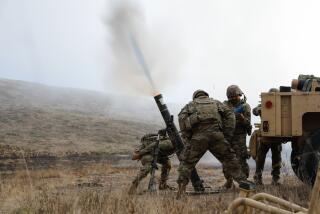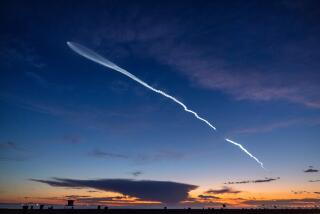Island Takes Aim at U.S. Bombing Range
- Share via
VIEQUES, Puerto Rico — Might or right: It’s a decades-old debate on this island of white sand beaches that doubles as the only remaining bombing range in the Atlantic.
“We’re living in a war zone,” complains Gilberto Clark, a nature guide.
The U.S. Navy occupies two-thirds of Vieques, leaving residents only the middle strip of this 21- by 4-mile island off Puerto Rico’s eastern coast. American troops have used it to prepare for every military engagement since 1941, when the government bought the land for $1.4 million.
Armies and navies from around the world send personnel to train on the eastern end of Vieques, dropping bombs on this hilly outcrop atop coral reefs and conducting other military exercises 235 days a year.
Clark and other residents complain about the booming explosions that sometimes go on for days, shaking the ground like earthquakes.
On days when dangerous exercises are underway, an orange flag warns civilians to stay clear of the base, which has the best beaches and good fishing spots that are open to the public. In September, a scuba diver contracted the bends when he was frightened by an underwater explosion and swam to the surface too quickly.
The Navy denies residents’ charges that its bombs have destroyed fragile island and marine ecosystems, hurt fishermen’s livelihoods and kept tourists away.
Islanders blame the Navy’s presence for Vieques’ high unemployment, which officially is around 50%.
“This land could be used for factories, or to expand tourist facilities,” said Luzcelenia Hernandez, a teacher. “Instead, our island is a military playground, with bombs exploding at our doorsteps.”
Now relations are being further strained by a federal government plan to install a radar station on Vieques to help detect drug-smuggling planes. The announcement dashed hopes that an end to the Cold War would mean a Navy pullout.
Opponents charge that the radar poses a cancer threat.
Vice Adm. Diego Hernandez, former chief of the Navy’s Caribbean force, denies there are health risks, saying the transmitter will have a mile-wide buffer zone.
That assurance is not enough for the 9,000 islanders, who already have the highest cancer rate in Puerto Rico.
Dr. Rafael Castano, a member of the Committee for the Rescue and Development of Vieques, blames the stress of military activity for the cancer rate, the equivalent of 208 per 100,000 residents. The average for all of Puerto Rico is 120 per 100,000 residents.
Islanders express skepticism about a Navy study that discounts health risks, saying the Navy has lied to them before.
Robert Rabin, president of the Vieques advocacy group, points to the Navy’s recent denial that in October 1992, it dropped nearly 20 tons of bombs on Vieques and doused parts of the island with napalm--even though both actions were reported by El Navegante, the in-house Navy newspaper, at the time.
Navy officials argue that the military has benefited Vieques by preventing harmful development projects from polluting the island.
Lt. Toby de Mier, the Puerto Rican-born officer in charge of the base and its 70 sailors, says Vieques’ reefs are among the most pristine in the commonwealth.
“I snorkel there. I know,” he said.
Juan G. Gonzalez, a professor of marine sciences at the University of Puerto Rico, disagrees.
The bombing practice has torn craters in the surrounding reefs and killed vital marine vegetation, Gonzalez said.
Residents maintain an uneasy peace with base personnel, who, conspicuous in their military haircuts and military trucks, rarely venture into town.
But in May, about 35 fishermen tried to persuade six warships from Belgium and the Netherlands to pull out of Sun Bay, a popular tourist cove. The sailors refused and doused the fishermen with high-pressure fire hoses. Each side hurled tools. The fishermen claim the sailors fired tear gas. Hundreds of European soldiers and sailors were around Vieques at the time, including 1,100 from Germany.
A Navy spokesman, Raul Duany, said such incidents are rare and argued that most Puerto Ricans see the military as an important source of jobs. Indeed, residents of Aguadilla, a town on Puerto Rico’s main island, are lobbying to have an abandoned military base there become the new home for Army troops when the U.S. Southern Command leaves Panama.
“The Southern Command is a necessity here,” said Willie Morales, a vegetable seller in Aguadilla who is hopeful of getting a job.
But residents of Vieques disagree.
“People in this community are willing to do whatever is necessary, including civil disobedience, to defend their right to live without this military craziness,” said Rabin, surveying the island from a 16th century Spanish fort, the legacy of Puerto Rico’s first colonizers.
More to Read
Sign up for Essential California
The most important California stories and recommendations in your inbox every morning.
You may occasionally receive promotional content from the Los Angeles Times.










